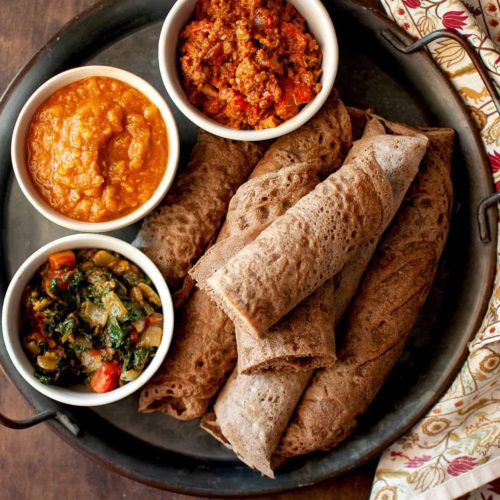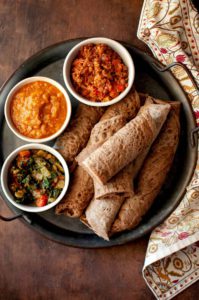Injera is a staple Ethiopian flatbread that is central to the country’s cuisine. This spongy and tangy bread is made from fermented teff flour and is traditionally served with various Ethiopian dishes. Injera is not only a delicious accompaniment but also an integral part of the Ethiopian dining experience. In this recipe, we will guide you through the steps of making authentic Ethiopian Injera so you can enjoy this unique and flavorful bread at home.

Authentic Ethiopian Injera Recipe
Experience the taste of Ethiopia with this authentic Injera recipe. Made from fermented teff flour, this spongy and tangy flatbread is a staple in Ethiopian cuisine. The process of fermenting the batter gives Injera its distinct flavor and texture. This versatile bread can be served with a variety of Ethiopian dishes, such as stews and curries, or used as a utensil to scoop up flavorful bites. Follow this recipe to create your own batch of Injera and transport your taste buds to the vibrant flavors of Ethiopia.
Equipment
- large mixing bowl
- whisk
- non stick pan
- lid
- Ladle
- spatula
Ingredients
- teff flour
- water
- dry yeast
- salt
Instructions
- In a large mixing bowl, combine the teff flour and water. Whisk or stir vigorously until a smooth batter is formed. Ensure there are no lumps in the mixture.
- If using active dry yeast for extra fermentation, dissolve it in a small amount of water and add it to the batter. Stir to combine.
- Cover the bowl with a clean kitchen towel or plastic wrap and let the batter ferment at room temperature for 24-48 hours. During this time, the batter will develop a slightly sour taste and a bubbly texture.
- After the fermentation period, the batter will have a thin layer of liquid on top. Stir the batter well to incorporate the liquid back into the mixture.
- Heat a non-stick skillet or Injera pan over medium heat. The pan should be hot but not smoking.
- Ladle or pour approximately 1/4 to 1/3 cup of the batter onto the hot pan, swirling it to evenly spread the batter in a circular shape. The batter should form a thin, crepe-like layer.
- Cover the pan with a lid or any suitable cover to trap the steam and help the Injera cook evenly.
- Cook the Injera for about 2-3 minutes, or until the surface appears dry and the edges start to lift slightly.
- Remove the Injera from the pan using a spatula and transfer it to a plate. Repeat the process with the remaining batter until all the Injera is cooked.
- Stack the Injera on a plate as you cook them, and cover them with a clean kitchen towel to keep them warm and prevent them from drying out.
- Serve the Injera warm alongside your favorite Ethiopian dishes. Tear off pieces of Injera and use them to scoop up the flavorful stews and curries.
Notes
Fermented teff flour is traditionally used to make Injera, as it adds a distinct flavor and texture. However, if you don't have access to fermented teff flour, you can use regular teff flour and ferment the batter for a longer period.
Adjust the amount of water in the batter as needed to achieve the desired consistency. The batter should be thin enough to spread easily but not too runny.
If the Injera sticks to the pan, lightly grease the pan with oil before pouring the batter for subsequent Injeras.
Leftover Injera can be stored in an airtight container or wrapped in plastic wrap and kept in the refrigerator for a few days. Reheat before serving.
Nutrition
Serving: 700g
Tried this recipe?Let us know how it was!






